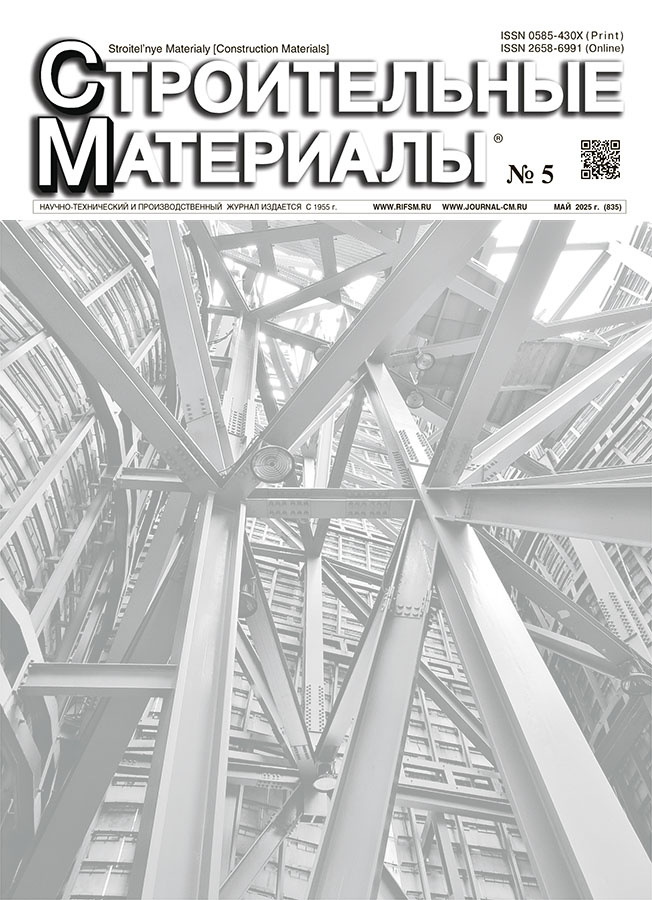Comparative assessment of free surface energy of cement clinker and carbonate rocks and the efficiency of their wetting with aqueous solutions of plasticizing additives
- 作者: Belyakov A.Y.1, Khokhryakov O.V.1, Nesterova K.O.1, Larionov I.S.2
-
隶属关系:
- Kazan State University of Architecture and Civil Engineering
- Kazan National Research Technical University named after A.N. Tupolev – KAI
- 期: 编号 5 (2025)
- 页面: 60-67
- 栏目: Results of scientific research
- URL: https://clinpractice.ru/0585-430X/article/view/684061
- DOI: https://doi.org/10.31659/0585-430X-2025-835-5-60-67
- ID: 684061
如何引用文章
详细
The study of adsorption phenomena at the interface of solids and aqueous solutions of surfactants is the basis for identifying the mechanisms of plasticization, water reduction and air entrainment of mineral-water systems. Obviously, the free surface energy of the solid phase plays a special role in these phenomena. In this work, the components of this energy (acid-base and dispersion) for various mineral materials (cement clinker and limestones) were determined by the wetting angle method, and the effect of aqueous solutions of plasticizing additives on this indicator was estimated. It was shown that in materials with a relatively high SiO2 content, the acid component γs+ significantly prevails, while in materials with a low proportion of SiO2 and an increased content of CaO+MgO, the basic component γs– of the surface energy predominantly manifests itself. This allows us to estimate the efficiency of aqueous solutions of cement concrete plasticizers, which are strong anion-active substances that are intensively adsorbed on the surface of materials with a pronounced basic component. The wetting angle of cement clinker and limestones with aqueous solutions of industrial plasticizers of different nature was studied: “Polyplast Ligno” based on sodium lignosulfonates, polynaphthalene methylsulfonate “SP-1” and “PC-1701” – a modified polycarboxylate ether. It was found that the most effective of them was the superplasticizer “PC-1701”, which even at an insignificant concentration (0.1%) reduces the contact angle of wetting on the surface of medium-strength limestone by 29.3%.
全文:
作者简介
A. Belyakov
Kazan State University of Architecture and Civil Engineering
编辑信件的主要联系方式.
Email: belyakoffandrrey@mail.ru
Engineer, Postgraduate Student
俄罗斯联邦, 1, Zelenaya Street, Kazan, 420043O. Khokhryakov
Kazan State University of Architecture and Civil Engineering
Email: olvik@list.ru
Doctor of Sciences (Engineering)
俄罗斯联邦, 1, Zelenaya Street, Kazan, 420043K. Nesterova
Kazan State University of Architecture and Civil Engineering
Email: nesterova4301@mail.ru
Master’s Student
俄罗斯联邦, 1, Zelenaya Street, Kazan, 420043I. Larionov
Kazan National Research Technical University named after A.N. Tupolev – KAI
Email: larionov_igor1999@mail.ru
Engineer, Postgraduate Student
俄罗斯联邦, 10, K. Marxa Street, 420111, Kazan参考
- Shakhova L.D., Kotlyarov R.A., Chernositova E.S. On the mechanism of action of cement grinding intensifiers. Tsement i Ego Primeneniye. 2023. No. 1, pp. 104–111. (In Russian). EDN: MQKKOW
- Tazhibaev K.T., Sultanalieva R.M., Konushbaeva A.T. Surface energy of minerals and rocks. Vestnik of the Kyrgyz State Technical University named after I. Razzakov. 2013. No. 29, pp. 261–267. (In Russian). EDN: YPHZGH
- Kalashnikov V.I., Moroz M.N., Tarakanov O.V., Kalashnikov D.V., Suzdaltsev O.V. New ideas about the mechanism of action of superplasticizers, co-ground with cement or mineral rocks. Stroitel’nye Materialy [Construction Materials]. 2014. No. 9, pp. 70–75. (In Russian). EDN: SNLKAH
- Vovk A.I. Adsorption of superplasticizers on the hydration products of Portland cement clinker minerals. Process patterns and structure of adsorption layers. Kolloidnyy Zhurnal. 2000. Vol. 62. No. 2, pp. 161–169. (In Russian). EDN: ZXFVRI
- Tarakanov O.V., Ivaschenko Yu.G., Erofeeva I.V. Influence of carbonate mineral additives on the formation of microstructure and strength of mineral binders. Regional’naya Arkhitektura i Stroitel’stvo. 2024. No. 1 (58), pp. 47–58. (In Russian). EDN: DQBVJX https://doi.org/10.54734/20722958_2024_1_47
- Smirnov D.S., Mavliev L.F., Khuziakhmetova K.R., Motyygullin I.R. Influence of mineral additive based on ground blast furnace slag on the properties of concrete and concrete mixtures. Izvestia of KSUACE. 2022. No. 4 (62), pp. 61–69. (In Russian). EDN: KQDLZR. https://doi.org/10.52409/20731523_2022_4_61
- Morozova N.N., Gulyakov E.G. Properties of concrete on zeolite-containing binder. Izvestia of KSUACE. 2023. No. 2 (64), pp. 27–39. (In Russian). EDN: LCQWVC. https://doi.org/10.52409/20731523_2023_2_27
- Batrakov V.G. Modifitsirovannyye betony. Teoriya i praktika [Modified concrete. Theory and practice. 2nd ed., revised and enlarged]. Moscow. 1998. 768 p. EDN: ZTDODP
- Plank J., Winter C. Competitive adsorption between superplasticizer and retarder molecules on mineral binder surface. Cement and Concrete Research. 2008. Vol. 38. Iss. 5, pp. 599–605. EDN: MKSHJD. https://doi.org/10.1016/j.cemconres.2007.12.003
- Gizzatullin A.R., Morozova N.N., Nesterova K.O. Functionalized fillers for use in cement concretes. Polimery v Stroitel’stve: scientific online journal. 2023. No. 1 (11), pp. 47–57. (In Russian). EDN: CBGPNV
- Ibragimov R.A., Potapova L.I., Korolev E.V. Study of structure formation of activated nanomodified cement stone by IR spectroscopy. Izvestia of KSUACE. 2021. No. 3 (57), pp. 41–49. EDN: XHUPYY. https://doi.org/10.52409/20731523_2021_3_41
- Can M.F. Determination of mineral surface energy using impact of rough topography. Physicochemical Problems of Mineral Processing. 2019. Vol. 55 (4), pp. 1002–1013. https://doi.org/10.5277/ppmp19022
- Arkhipov V.A. et al. Determination of wettability characteristics of powder materials. Izvestia of Universities. Physics. 2012. Vol. 55. No. 7–2, pp. 20–26. (In Russian). EDN: PXKTKR
- Valiev A.I., Starovoitova I.A., Suleimanov A.M. Adhesive interaction in a hybrid composite. Relationship of energy characteristics of phases with strength. Vestnik of the Belgorod State Technological University named after V.G. Shukhov. 2024. No. 3, pp. 17–26. (In Russian). EDN: NXNCHT. https://doi.org/10.34031/2071-7318-2024-9-3-17-26
- Ibragimov R.A., Korolev E.V., Bikaeva Yu.V., Larionov I.S. The contact angles of quartz and caustic dolomite powders after mechano-magnetic treatment. Stroitel’nye Materialy [Construction Materials]. 2024. No. 3, pp. 64–70. (In Russian). EDN: CUIUFP. https://doi.org/10.31659/0585-430X-2024-822-3-64-70
补充文件










